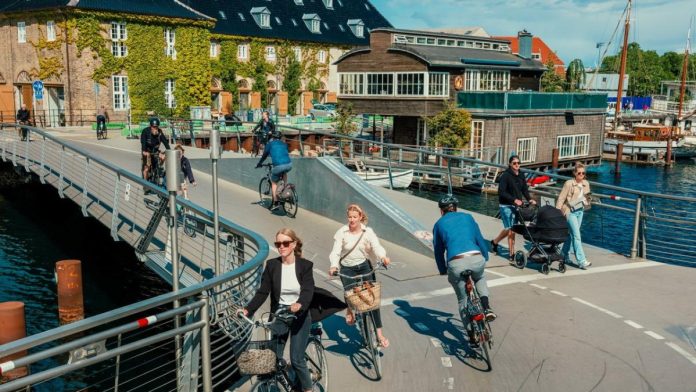The district north of the old hippie community of Christiana does not yet have a nickname that sums up what is currently being created here: spectacular, modern architecture between historic military and industrial buildings, where the hottest design, art and gastronomy addresses in the world are located move into the city. HipHolm maybe?
Holmen is the name of the group of several islands connected by bicycle bridges that were formerly an industrial area and naval base. A few excavators are still working to fill up the last bathing terraces and boat docks, but a kind of Nordic Venice Beach feeling is already emerging when the Baltic Sea sky shines in royal blue and the temperatures climb to over 20 degrees. You cycle to the sound of seagulls past houseboats, some super modern, others rustic Pippi Longstocking barges, pretty cafes and boat bars, cannon depots from the 17th century that have been converted into elegant townhouses whose gardens end right at the water's edge. The most exciting addresses in Copenhagen can be found on a good four kilometers of cycle paths.
1.
The conversion of Holmen began in 2005 with the opera. Since last year it has also been Opera Park completed, also by the Cobe architectural firm: a place full of Zen. You walk through labyrinths of wildflowers and everywhere you find a small meadow for a siesta by the water. The pavilion, whose architecture visually merges with nature thanks to its organically curved glass walls and green roof, is now home to the fine-dining restaurant and café Vaekshuset, from which you can reach the opera's underground car park through a vertical garden.
2.
The most central address to experience the new district is the one that has just opened 25hours Hotel Paper Island. Named after the location of the former paper factory, its unusual silhouette is visible from afar. The Danish office Cobe designed the entire complex, thereby adding the final piece of the puzzle to the major urban development project Holmen. The residential buildings of different heights with sloping side walls rise up like houses of cards. The porous, coal-fired bricks appear archaic and modern, rural and urban at the same time. A style that continues inside the hotel. The Swedish interior designers from “Stylt Trampoli” sum up the holiday flair of Holmen: The rooms are reminiscent of cozy Scandinavian weekend houses, with sea-colored wooden walls, floral wallpaper and walnut furniture, which are contrasted with elegant brass details.
3.
The legendary Noma 2.0., which founded New Nordic Cuisine in 2003, is on the route. René Redzepi actually wanted to close this year, but now things will continue until 2025. Even if you don't want to eat, it's worth a stop to see the architecture by Bjarke Ingels (BIG), who described the restaurant location in 2018 as a kind of urban Greenhouse designed.
4.
Interested in skiing? Four minutes further east is another highlight of the Danish architectural star: the 100 meter high Amager Resource Centera power plant that converts waste into energy, was the “World Building of the Year” in 2021 and is now considered the city’s local mountain. On the roof is “CopenHill”: a 450 meter long plastic ski slope, next to which you can walk on panoramic trails (free) or climb the highest outdoor climbing wall in the world.
5.
Refshaleøen is the northernmost island and the end point of the four kilometer long tour. Once again we come across Bjarke Ingels: his floating “Urban Riggers“-inexpensive living containers for students – are in the water here. The site of a former shipyard is home to the city's largest contemporary art center: The Copenhagen Contemporary (CC). Monumental works, performances and video art are shown in the 7,000 square meter welding hall. The James Turrell light installation “Aftershock” alone is worth the trip.
6.
It's also a few steps further immersive: hidden in an inconspicuous industrial hall is the “Alchemist“ by Rasmus Munk, in the top 10 of the best restaurants in the world for the second time in a row this year. Although: It's more of an art installation, theater, performance and six-hour journey through different rooms, during which 50 edible “impressions” are served, from frosted butterflies to pig's blood sorbet. Getting one of the “tickets”, which cost around 720 euros (excluding drinks), takes at least three months of planning, speed and luck.
7.
Eating is easier and quicker on the huge “Reffen Street Food Market next door. Almost all cuisines in the world are represented here and of course the Danish rye bread sandwich, the Smørrebrød. When the weather is nice, a real festival atmosphere arises between the colorful stands and beer tables, with DJ acts and live concerts accompanying the hustle and bustle.


